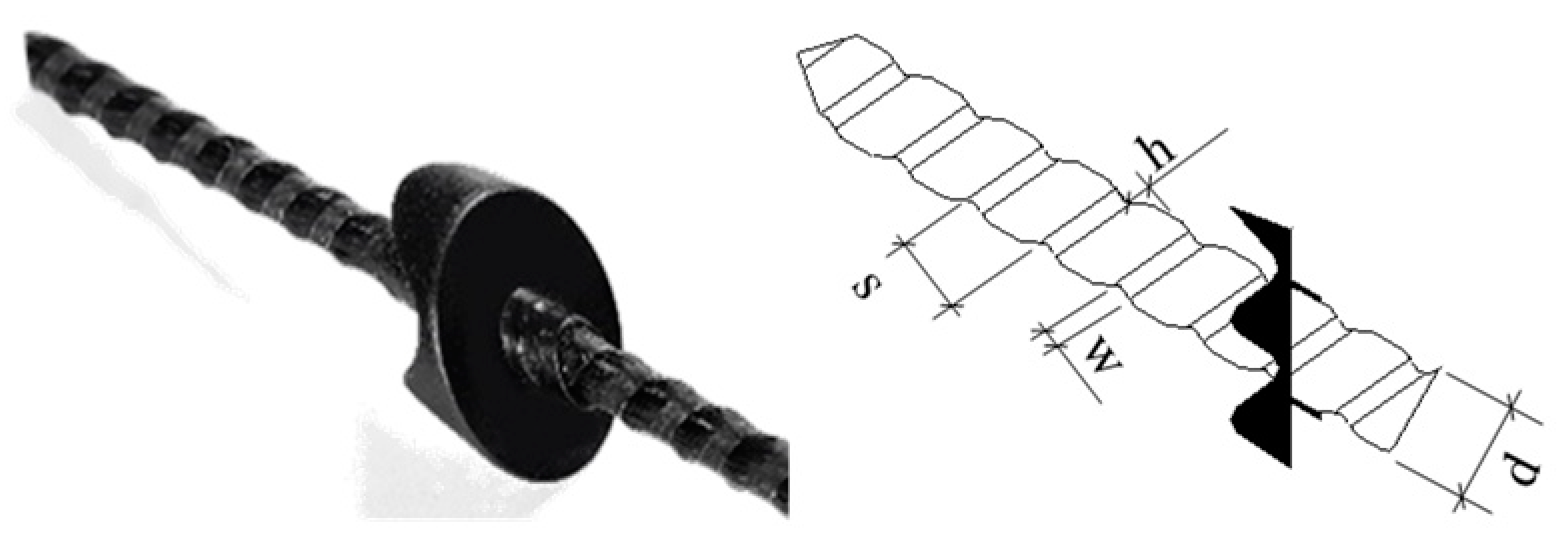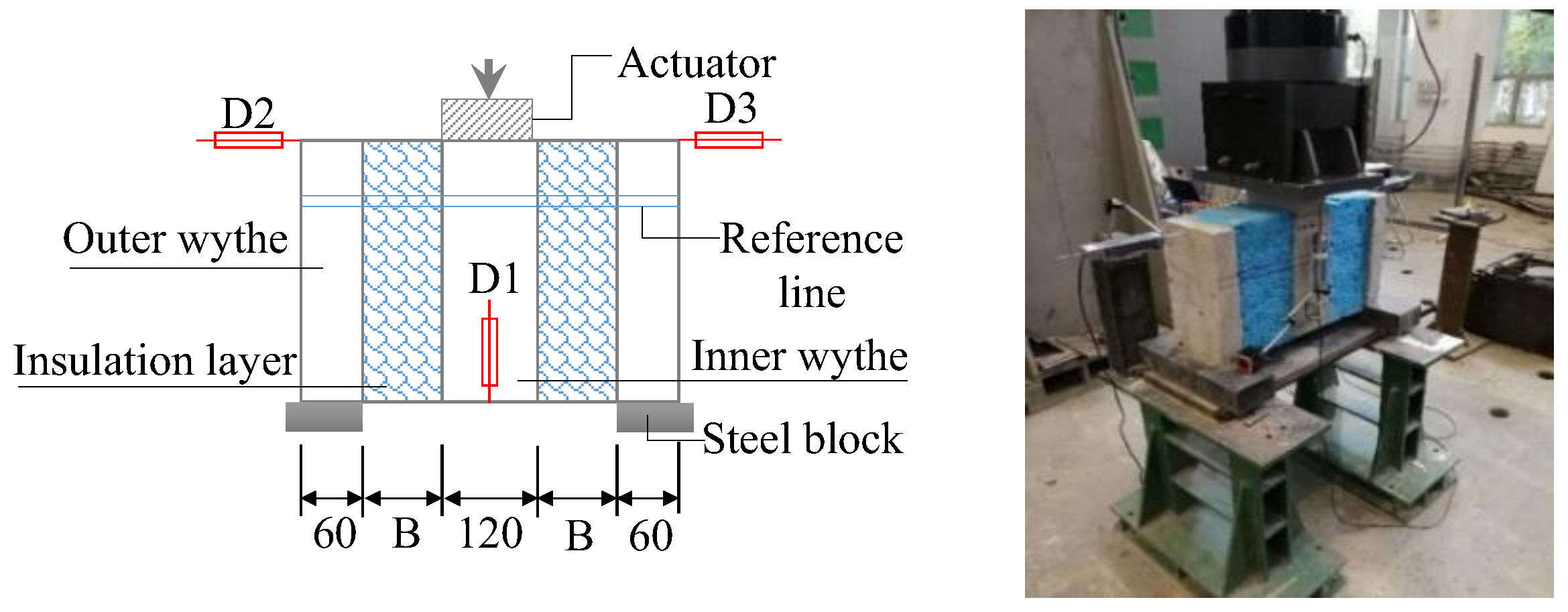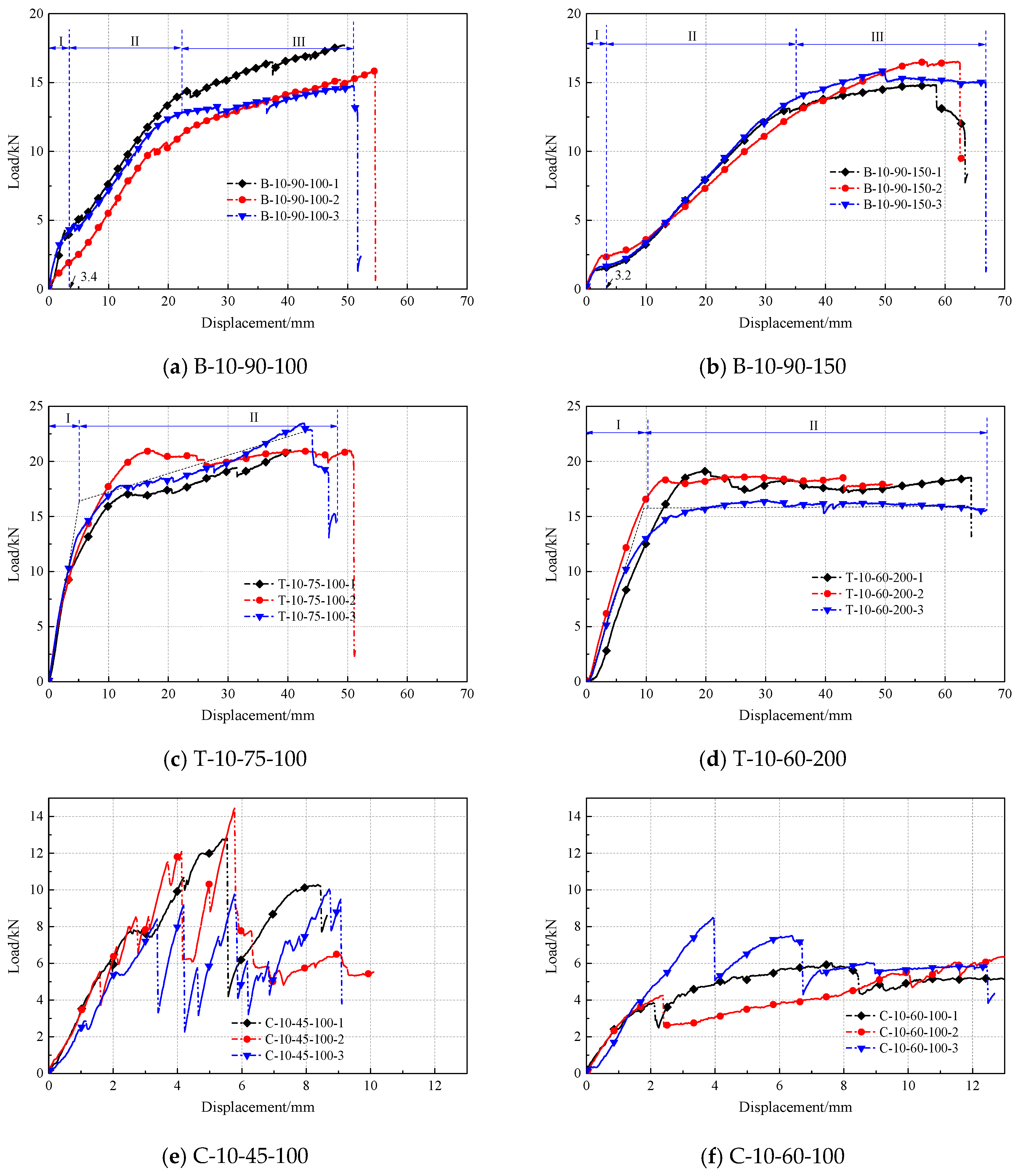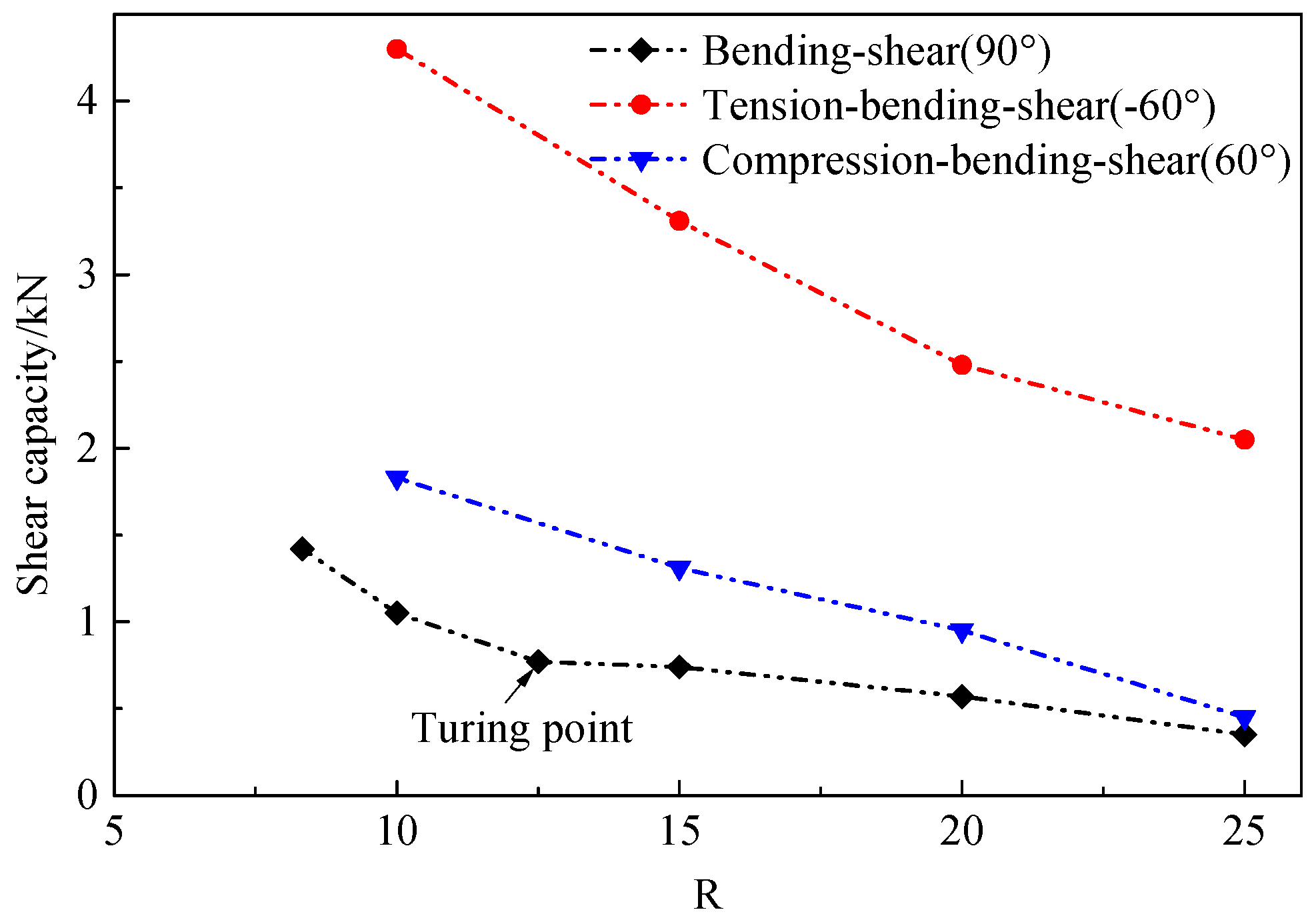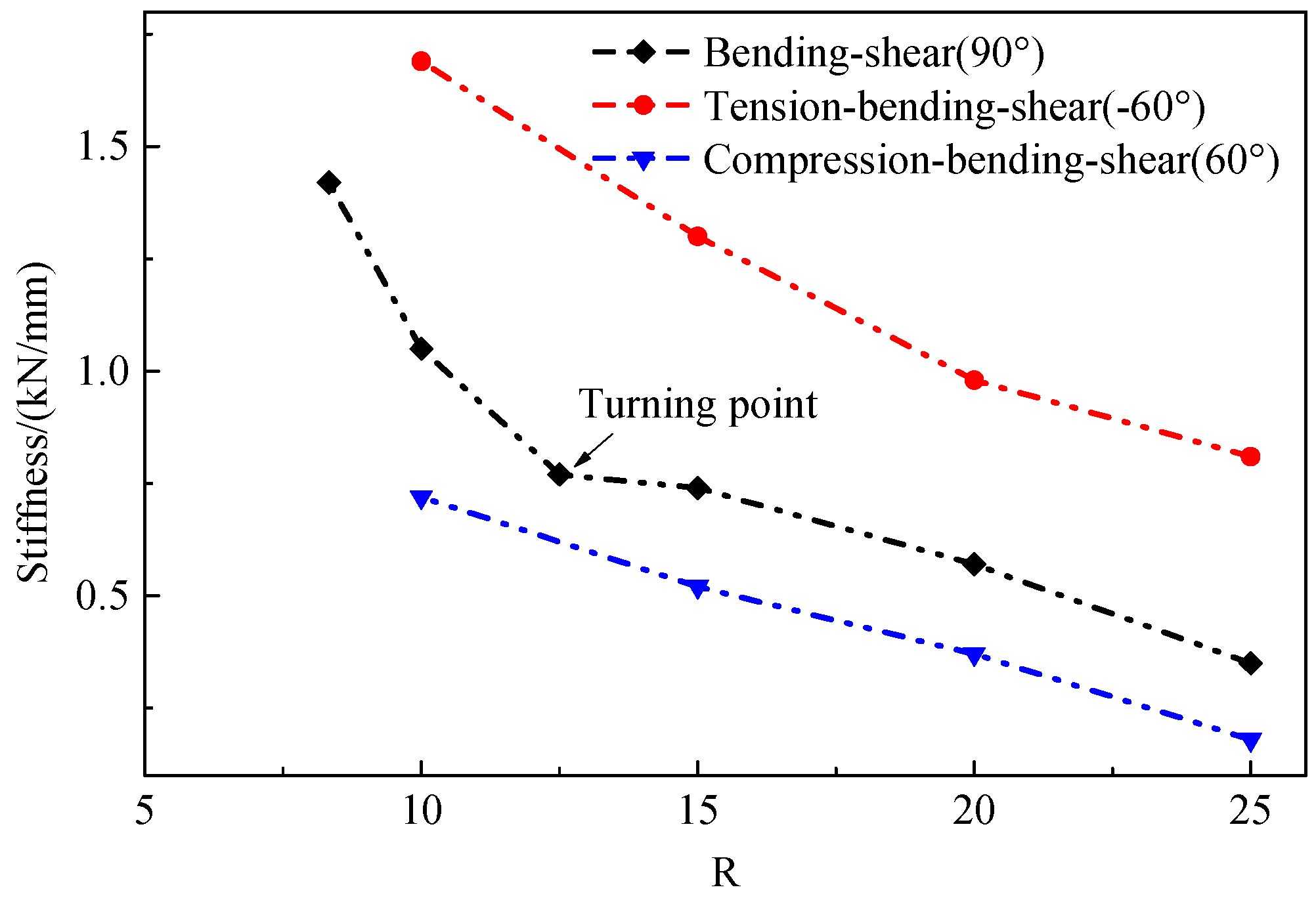1. Introduction
Typical insulated precast concrete sandwich panel (PCSP) systems are composed of two concrete wythes separated by a layer of insulation [
1]. Connectors penetrate the insulation layer and join the two concrete wythes to ensure they work together [
2]. The structural properties of PCSP systems depend largely on connectors, which are designed to carry gravity loads from floors or roofs and to resist lateral loads caused by wind as well as external effects caused by earthquake. Connectors are known to be divided into three types, including ordinary steel connectors, alloy connectors and fiber-reinforced polymer (FRP) connectors [
3]. Though ordinary steel bar connectors have advantages of low cost and convenient installation, the thermal bridge effect could not be avoided due to their relatively high thermal conductivity [
4]. Therefore, it is difficult to meet the requirements of energy-saving indicators for insulated PCSP systems [
5]. In addition, the poor corrosion resistance of steel connectors was a potential safety hazard to insulated PCSP systems. Compared to steel connectors, the alloy connectors have good corrosion resistance, durability and low thermal conductivity, while the lifecycle costs of this type were significantly increased [
6]. In the recent two decades, FRP connectors have leaped forward due to their high strength and stiffness, as well as proven durability combined with lower thermal conductivity relative to conventional metallic connectors [
7]. Generally, FRP has a thermal conductivity approximately 1/150 that of steel and 1/30 that of concrete [
8]. Therefore, it will have broad engineering application prospects in the field of ultra-low-energy residential engineering [
9,
10,
11].
FRP connectors in insulated PCSP systems have gained widespread attention nowadays. Experimental study on fourteen different types of commercially available FRP ties has been conducted [
12]. Their failure modes and responses were quantified, and the simplified engineer-level multilinear strength curves were developed for each connection. Xue et al. [
13] have proved the efficiency of FRP connectors by corrosion test in a concrete alkali environment with a temperature of 60 °C, where the safety factor of shear resistance could reach 8.0 after 183 aging days. Three types of GFRP connectors produced from available sand-coated and threaded rods were tested and compared to conventional steel as well as polymer connectors [
14]. The shear strength of GFRP connectors ranged from 60 to 112 MPa, which reach 1/3 that of conventional steel connectors. Forty-six segments representing precast concrete sandwich panels using CFRP grid connectors were adopted by Hodicky et al. [
15], and the shear transfer mechanism of the CFRP grid connectors was elaborated. Tomlinson et al. [
16] studied BFRP-reinforced partially composite precast concrete insulated wall panels with BFRP shear connectors, indicating that the tested walls have between 60% and 90% of the strength of all-steel reinforcement and connectors. Thirty-eight push-through tests were performed on a precast concrete insulated sandwich panel using combined angled and horizontal BFRP connectors [
17]. The research indicated that the steel and BFRP connectors have similar strengths in tension stress mode; both the strength and stiffness increase with the connector angle and diameter. In order to evaluate the bonding performance between BFRP connectors and concrete wythes, the pull-out test with surface winding and sandblasting connectors have been carried out, where excellent bonding performance was evidenced with the bonding stress of 13.9 MPa [
18]. Salam Al-Rubaye et al. [
19] studied four different types of GFRP connectors on their stiffness, strength and ductility, and the shear failure mechanism of different connectors has been revealed. The precast sandwich wall panel using recycled aggregate and angled BFRP shear connectors was developed by Xie et al. [
20]. Notable advantages in terms of the bearing capacity and ductility over panels with commercial GFRP needle connectors have been evidenced. Choi et al. [
21] used GFRP grids to enhance both the structural and thermal performances of insulated concrete sandwich wall panels. All specimens exhibited sufficient flexural performance satisfying the strength presented in the current code, demonstrating 2.70–3.63 times higher strength capacities than the design load. Diagonal shear connectors of GFRP bars with diameter of 4 mm were adopted by Sylaj et al. [
22], while the governing failure mode for all panels is the fracture of the GFRP shear connectors.
In fact, the anchorage length of connectors in concrete is relatively small due to the thickness limit of concrete wythes. Thus, a series of structural measures have been taken on FRP connectors to improve the mechanical anchorage capacity, including increasing the spacing between the vertical lines of the CFRP grid [
15], slotting on panel-type FRP connector [
23], “Cross” design at both anchorage ends of connectors [
12], crisscross for rod connector [
19], surface winding or sandblasting [
18], etc. However, CFRP grids were susceptible to tension rupturing and compression buckling with the increased spacing. While for panel-type connectors, the moments of inertia in two directions were different, which has a great impact on their mechanical performance in PCSP systems. Moreover, the FRP connectors with “Cross” design have the disadvantage of complex manufacture and installation, and it is easy to cause damage to the insulation layer due to their expanded tips. The surface winding or sandblasting treatments improved the bond performance while the cost increased. Therefore, an improved integrated deep-ribbed BFRP connector manufactured by pultrusion process was introduced in this paper. This type of BFRP connector has benefits of simple structure, convenient installation, low thermal conductivity and excellent bonding performance with the concrete, which will provide an alternative scheme for the selection of connectors. There is a primary need to explore influencing factors and to develop constitutive laws for the BFRP connector in insulated PCSP systems.
For this purpose, the paper presents an experimental investigation of segments representing a typical PCSP, as shown in
Figure 1. A total of 58 specimens using BFRP connectors were adopted in double shear tests to obtain failure modes, load displacement curves and shear capacity. Parameters of the BFRP connector’s diameter, thickness of insulation layer, installation angle, layout spacing and combined action were analyzed. Test results were used to develop a model of shear capacity to provide references for the design and selection of BFRP connectors in engineering applications.
4. Conclusions
PCSP systems have been the preferred approach due to accelerated building construction, reduced construction costs and enhanced performance. Moreover, the adoption of nonmetallic connectors such as the BFRP connector can satisfy the structural insulation requirements due to its low thermal conductivity. The parameter study on BFRP connectors in this paper could provide an alternative option for insulated PCSP systems reinforced with FRP connectors.
Based on the double shear tests of insulated PCSP systems reinforced with BFRP connectors, the failure modes, load displacement curves and load capacity were obtained. The influences of BFRP connectors’ span ratio, installation angle, layout spacing and combined action on the shear capacity were analyzed. The models for prediction of shear capacity and the maximum shear force were proposed. The following conclusions can be summarized:
- (1)
BFRP connectors experience typical failure modes changing from inter-laminar shear failure to the connector fracture and then to the concrete split with the decrease in the installation angle. This is attributed to the transformation of stress modes caused by different installation angles.
- (2)
Stress modes have a great effect on discreteness of the load-displacement curves. Those of bending-shear and tension-bending-shear keep consistent, while that of the compression-bending-shear exhibits large, dispersed characteristics due to buckling of connectors.
- (3)
The BFRP connector’s span ratio of not larger than 15 and installation angles of 60° or 75° were recommended for suitable stiffness and shear bearing capacity. The influence of layout spacing between 300 mm and 500 mm on shear capacity was relatively small, where the maximum error was 2.2%. The material performance will be fully utilized with suggested parameters for practical implementation.
- (4)
For the design of BFRP connectors with a plane or spatial combination, the shear force can be calculated by linear superposition of a single BFRP connector’s shear force. It facilitates the design of an insulated PCSP system with various combinations.
- (5)
The prediction models for shear capacity and the maximum shear force exhibit good accuracy with correlation coefficients (R2) of 0.982 and 0.946. It could provide a basis for the design and selection of BFRP connectors, especially for an insulated PCSP system with thick insulation layers within 200 mm.
This paper provides a preliminary study on the shear behavior of insulated precast concrete sandwich panels reinforced with BFRP connectors. Parameters including the span ratio, installation angles and layout spacing have been suggested for BFRP connectors in future engineering applications. The proposed models for shear capacity and the maximum shear force could provide a favorable design option of an insulated PCSP system by conforming to the required design criteria.

